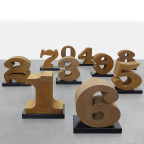Biography
This is the first solo exhibition of Robert Indiana to be seen in London for over ten years, and it brings together works from various stages in the artist’s career, beginning with a number of rarely shown early works including the large imposing Melville Triptych of 1961, a major painting of the period. Three LOVE sculptures testify to his continuing preoccupation with one of the most celebrated images from the sixties, while another group of sculptures reveals Indiana’s long-held appreciation of the formal beauty of the cardinal numbers. As an artist who has never dodged political commitment, Indiana’s response to the war in Iraq resulted last year in the Peace Paintings which, far from indulging in the rhetoric of protest, are shaped in elegiac phrases reminiscent of the great poets of the First World War.
As Adrian Dannatt points out in his catalogue essay, much of Indiana’s work could be analyzed in the tradition of historical shaped poems, Dadaist visual-poetry, the French Lettriste movement or the emergent aesthetics of Concrete Poetry. Indiana has always seen himself as a poet, and his art makes full use of the hidden meanings and ambiguity found in many of his favourite writers including Gertrude Stein, Stéphane Mallarmé and W.B. Yeats. His deep appreciation of language and poetry is matched by his regard for history which he also approaches in the spirit of ambiguity, simultaneously celebrating and questioning institutions such as the monarchy, or utopian visions such as the American dream.
The elementary language and impressive scale of American highway signs made a deep impression on Indiana even as a small child, and that unmediated directness has become the bedrock of an imagery that appears uncomplicated yet is rich in meaning and intention. Indiana’s art, writes Adrian Dannatt, is one of surface simplicity, of the boldest, brightest and most effective forms and colours, an apparently basic message that requires no further elucidation, where what you see is what you get. But it is precisely in this seeming directness, this candour, that his work is at its slyest and slipperiest, the flat dazzle concealing a deep arcane network of winks, allusions and deadpan wit.







